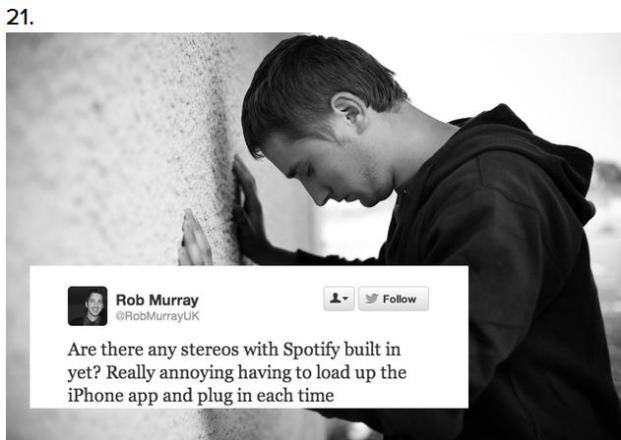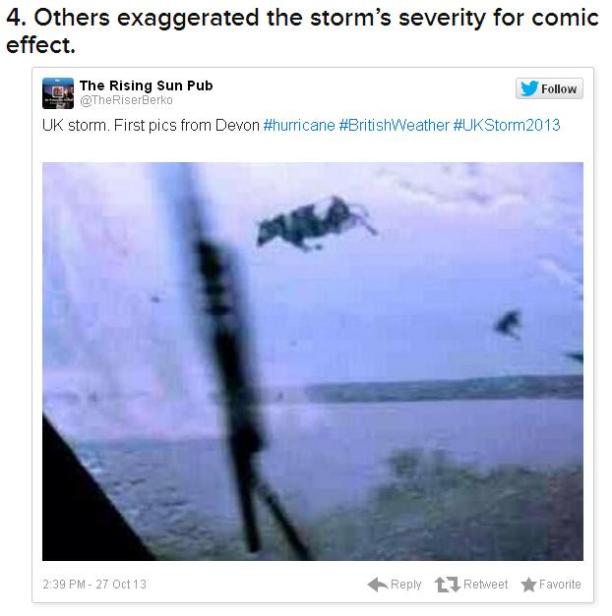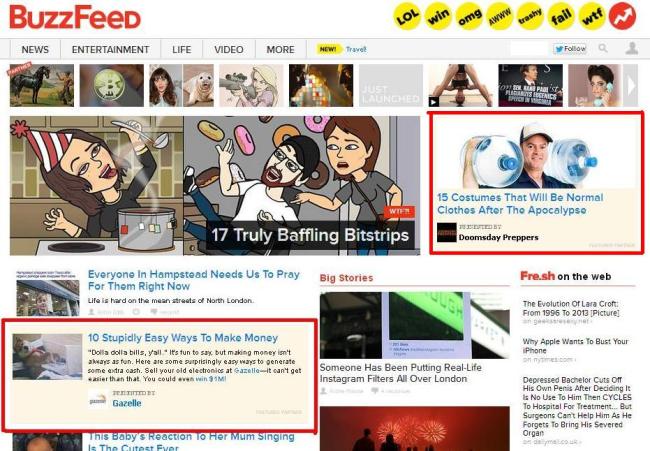The Future of Mobile
10 Reasons @BuzzFeed Is The Future of Content
1. The titles of its posts are just weird enough to intrigue.
Just long enough to give you a good sense of the article and snappy enough to make it easier to click than wonder what you might have missed out on by not clicking…
2. The content for Buzzfeed stories is frequently sourced from Twitter AKA REAL LIFE.
I myself found fame after being unwittingly featured in ‘27 Middle-Class Problems‘, after *jokingly* tweeting about Spotify. Cue tweets telling me i’m famous – well the article was tweeted 7,500 times!
3. The writers are brought to the forefront.
As well as the post author’s name appearing at the top of an article, the URL for each story/list/piece goes http://www.buzzfeed.co.uk(com)/AUTHORNAME/ARTICLENAME. People buy people. Or familiarity breeds contempt. One or the other. I personally remember the author of a particularly good post and will be more likely to read that author’s future musings/listings.
4. It’s just so goddam visual and succinct.
Long-winded textual explanations of the state of the housing market are for CEO’s reading the Financial times at a leisurely pace whilst eating their egg and soldiers. Buzzfeed is for us young-uns (32’s young right?) looking for that next fix of heady content. Any text in a Buzzfeed article is usually their to explain the image/gif/video. Time is money people, and a gif tells a thousand words.
5. Easy touch points of engagement.
In these time and attention scarce times, you need to make it flippin easy for people to engage. Buzzfeed does this by giving you an easy set of loose adjectives to click. Browsing readers can then sort content by the most ‘OMG’ or ‘wtf’. Win!
6. It’s starting to take itself seriously
There will always be a place for cat gifs on Buzzfeed but the site has recently made a lot of new hires as it tries to make in-roads to serious journalism, presented in a Buzzfeed style format. They’ve hired Pulitzer winning Mark Schoofs to head up their ‘Investigative Unit’ and The Guardian’s Moscow bureau chief, Miriam Elder to be their Foreign Editor. Today they’ve tackled the housing crisis through a well laid out, easy to understand post entitled ’15 Facts That Reveal The Utter Insanity of The Housing Market’ by Daniel Knowles of The Economist. As I saw someone say on Twitter – this WILL be the way the next general election is sold to the younger generation. That may be good for engaging a previously inert segment, or bad for the bias in the way the arguments are laid out. Reporting serious subject matter brings added responsibility and a requirement to show both sides of an argument. That doesn’t get clicks though.
7. The breadth of subject matter!
From ‘The 14 Craziest Things Russia’s Top Doctor Ever Said’ and ’16 Horses That Look Like Miley Cyrus’, to the aforementioned article on over-population and the UK housing crisis – there’s a lot going on!
8. They’re monetizing already
Not through garish banner ads skyscraping their way down half the screen. No, the ads on Buzzfeed are stories written by advertisers or ‘partners’ and appear in the same content stream as regular Buzzfeed posts. These advertorials indicate that they are from a featured partner and have a shaded background – but if the title’s interesting, people are going to click and read…
9. User generated content
As well as hiring big names in the world of journalism to write for them Buzzfeed also leverages to creativity of its readers. The Buzzfeed community members are able to create their own posts, and watch them spread like wildfire from the internet. In fact, their UK Editor, Luke Lewis was quoted as saying today at the #BBCSocial event, that the best community contributors may even be offered a job with Buzzfeed, Swell.
10. Other news networks are beginning to mimic the Buzzfeed way
From the BBC to The Guardian and Independent, the was truncated, easy to digest format of Buzzfeed articles is impossible to ignore and affecting the style in which other present their own news.
A Lesson In Content Marketing on Twitter by @WaterstonesOxfordSt (sorry @hmvtweets)
In case you’ve been living in a dark room, wearing ear mufflers you will know that the feisty 80’s quiffer Morrissey has released his autobiography. What interested me however was the contrasting ways of promoting the book on Twitter by two UK retailers; Waterstones and HMV.
Waterstones – Unique, Funny Content
Waterstones created a piece of unique and relevant content – a photo of the Morrissey book standing next to a book on the English Legal System (Morrissey has always liked a dig at the judiciary). Equal parts relevant and humorous the tweeted photo resulted in 133 retweets and 73 favourites. 
HMV – Stock Photography
HMV also tweeted about the new book. The same subject matter from a high street retailer just as well known as Waterstones (in fact more Twitter followers), yet this generated just 13 retweets and 12 favourites.
The moral of the story? It’s not enough to state that something has happened. Brands tweeting need to add their own perspective and brand personality to every tweet. A touch of humour and relevance and you’re away. This particular Waterstones account has just 47k followers compared to HMV’s 77k – so 30,000 less followers but a lot higher engagement levels!
Don’t even get me started on how brilliant the WaterStonesOxfordSt Twitter feed is in general…






